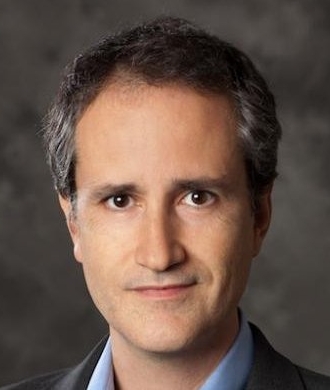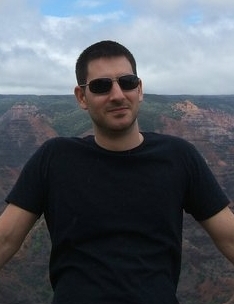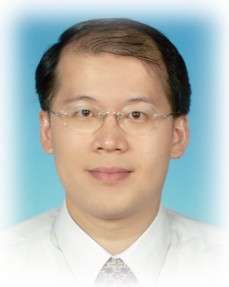- Date & Time: Thursday, March 21, 2013; 12:00 PM
Speaker: Prof. Antonio Ortega, University of Southern California
MERL Host: Anthony Vetro Abstract  Graphs have long been used in a wide variety of problems, such analysis of social networks, machine learning, network protocol optimization, decoding of LDPCs or image processing. Techniques based on spectral graph theory provide a "frequency" interpretation of graph data and have proven to be quite popular in multiple applications.
Graphs have long been used in a wide variety of problems, such analysis of social networks, machine learning, network protocol optimization, decoding of LDPCs or image processing. Techniques based on spectral graph theory provide a "frequency" interpretation of graph data and have proven to be quite popular in multiple applications.
In the last few years, a growing amount of work has started extending and complementing spectral graph techniques, leading to the emergence of "Graph Signal Processing" as a broad research field. A common characteristic of this recent work is that it considers the data attached to the vertices as a "graph-signal" and seeks to create new techniques (filtering, sampling, interpolation), similar to those commonly used in conventional signal processing (for audio, images or video), so that they can be applied to these graph signals.
In this talk, we first introduce some of the basic tools needed in developing new graph signal processing operations. We then introduce our design of wavelet filterbanks of graphs, which for the first time provides a multi-resolution, critically-sampled, frequency- and graph-localized transforms for graph signals. We conclude by providing several examples of how these new transforms and tools can be applied to existing problems. Time permitting, we will discuss applications to image processing, depth video compression, recommendation system design and network optimization.
-
- Date & Time: Thursday, March 21, 2013; 12:00 PM
Speaker: Konstantinos Tsianos, McGill, Montreal, Canada
MERL Host: Petros T. Boufounos Abstract  Distributed algorithms become necessary to employ the computational resources needed for solving the large scale optimization problems that arise in areas such as machine learning,computation biology and others. We study a very general distributed setting where the data is distributed over many machines that can communicate with one another over a network that does not have any specialized communication infrastructure. In this setting the role of the network becomes critical in the performance of a distributed algorithm. From a more theoretical standpoint we discuss two questions: 1) How many nodes should we use for a given problem before communication becomes a bottleneck? and 2) How often should the nodes communicate to one another for the communication cost to be worth the transmission? In addition, we discuss some more practical issue that one needs to consider in implementing algorithms that are asynchronous and robust to communication delays.
Distributed algorithms become necessary to employ the computational resources needed for solving the large scale optimization problems that arise in areas such as machine learning,computation biology and others. We study a very general distributed setting where the data is distributed over many machines that can communicate with one another over a network that does not have any specialized communication infrastructure. In this setting the role of the network becomes critical in the performance of a distributed algorithm. From a more theoretical standpoint we discuss two questions: 1) How many nodes should we use for a given problem before communication becomes a bottleneck? and 2) How often should the nodes communicate to one another for the communication cost to be worth the transmission? In addition, we discuss some more practical issue that one needs to consider in implementing algorithms that are asynchronous and robust to communication delays.
-
- Date: March 20, 2013
Where: Data Compression Conference (DCC)
MERL Contact: Petros T. Boufounos
Research Area: Computational Sensing
Brief - The paper "Efficient Coding of Signal Distances Using Universal Quantized Embeddings" by Boufounos, P.T. and Rane, S. was presented at the Data Compression Conference (DCC).
-
- Date: March 17, 2013
Where: Optical Fiber Communication Conference and Exposition and the National Fiber Optic Engineers Conference (OFC/NFOEC)
Research Areas: Communications, Signal Processing
Brief - The paper "A Baud-Rate Sampled Coherent Transceiver with Digital Pulse Shaping and Interpolation" by Millar, D., Lavery, D., Maher, R., Thomsen, B.C., Bayvel, P. and Savory, S.J. was presented at the Optical Fiber Communication Conference and Exposition and the National Fiber Optic Engineers Conference (OFC/NFOEC).
-
- Date: March 17, 2013
Where: IEEE Applied Power Electronics Conference and Exposition (APEC)
MERL Contact: Koon Hoo Teo
Research Areas: Applied Physics, Electronic and Photonic Devices, Electric Systems
Brief - The paper "Generalized DC-link Voltage Balancing Control Method for Multilevel Inverters" by Deng, Y., Teo, K.H. and Harley, R.G. was presented at the IEEE Applied Power Electronics Conference and Exposition (APEC).
-
- Date: March 14, 2013
Where: Proceedings of the IEEE
MERL Contacts: Bingnan Wang; William S. Yerazunis; Koon Hoo Teo
Research Areas: Applied Physics, Electric Systems
Brief - The article "Wireless Power Transfer: Metamaterials and Array of Coupled Resonators" by Wang, B., Yerazunis, W. and Teo, K.H. was published in Proceedings of the IEEE.
-
- Date: March 14, 2013
Where: SIAM Journal of Scientific Computing Brief - The article "Absolute Value Preconditioning for Symmetric Indefinite Linear Systems" by Vecharynski, E. and Knyazev, A.V. was published in SIAM Journal of Scientific Computing.
-
- Date & Time: Friday, March 8, 2013; 12:00 PM
Speaker: Prof. Hiroshi Mamitsuka, Kyoto University Abstract  Semi-structured data, particularly graphs, are now abundant in molecular biology. Typical examples are protein-protein interactions, gene regulatory networks, metabolic pathways, etc. To understand cellular mechanisms from this type of data, I've been working on semi-structured data, covering a wide variety of general topics in machine learning or data mining, such as link prediction, graph clustering, frequent subgraph mining, and label propagation over graphs and so on. In this talk I will focus on label propagation, in which nodes are partially labeled and the objective is to predict unknown labels using labels and links. I'll present two approaches under two different inputs in sequence: 1) only single graph and 2) multiple graphs sharing a common node set.
Semi-structured data, particularly graphs, are now abundant in molecular biology. Typical examples are protein-protein interactions, gene regulatory networks, metabolic pathways, etc. To understand cellular mechanisms from this type of data, I've been working on semi-structured data, covering a wide variety of general topics in machine learning or data mining, such as link prediction, graph clustering, frequent subgraph mining, and label propagation over graphs and so on. In this talk I will focus on label propagation, in which nodes are partially labeled and the objective is to predict unknown labels using labels and links. I'll present two approaches under two different inputs in sequence: 1) only single graph and 2) multiple graphs sharing a common node set.
1) Existing methods extract features, considering either of graph smoothness or discrimination. The proposed method extracts features, considering the both two aspects, as spectral transforms. The obtained features or eigenvectors can be used to generate kernels, leading to multiple kernel learning to solve the label propagation problem efficiently.
2) Existing methods estimate weights over given graphs, like selecting the most reliable graph. This framework is however unable to consider densely connected subgraphs, which we call locally informative graphs (LIGs). The proposed method first runs spectral graph partitioning over each graph to capture LIGs in eigenvectors and then an existing method of label propagation for multiple graphs is run over the entire eigenvectors.
I will show empirical advantages of the two proposed methods by using both synthetic and real, biological networks.
-
- Date: March 1, 2013
Where: IEEE Signal Processing Letters
MERL Contact: Jonathan Le Roux
Research Area: Speech & Audio
Brief - The article "Consistent Wiener Filtering for Audio Source Separation" by Le Roux, J. and Vincent, E. was published in IEEE Signal Processing Letters.
-
- Date: March 1, 2013
Where: Journal of Machine Learning Research (JMLR)
MERL Contact: Petros T. Boufounos
Research Area: Computational Sensing
Brief - The article "Greedy Sparsity-Constrained Optimization" by Bahmani, S., Raj, B. and Boufounos, P. was published in Journal of Machine Learning Research (JMLR).
-
- Date: March 1, 2013
Where: IEICE Technical Committee Conference (OCS/OFT/OPE)
MERL Contacts: Bingnan Wang; Toshiaki Koike-Akino; Kieran Parsons
Research Area: Electronic and Photonic Devices
Brief - The paper "An MMI-based Polarization Splitter using Patterned Metal and Angled Joint" by Kojima, K., Nishikawa, S., Yagyu, E., Yuan, W., Wang, B., Koike-Akino, T. and Parsons, K. was presented at the IEICE Technical Committee Conference (OCS/OFT/OPE).
-
- Date & Time: Tuesday, February 26, 2013; 12:00 PM
Speaker: Prof. Taylan Cemgil, Bogazici University, Istanbul, Turkey
MERL Host: Jonathan Le Roux
Research Area: Speech & Audio
Abstract  Algorithms for decompositions of matrices are of central importance in machine learning, signal processing and information retrieval, with SVD and NMF (Nonnegative Matrix Factorisation) being the most widely used examples. Probabilistic interpretations of matrix factorisation models are also well known and are useful in many applications (Salakhutdinov and Mnih 2008; Cemgil 2009; Fevotte et. al. 2009). In the recent years, decompositions of multiway arrays, known as tensor factorisations have gained significant popularity for the analysis of large data sets with more than two entities (Kolda and Bader, 2009; Cichocki et. al. 2008). We will discuss a subset of these models from a statistical modelling perspective, building upon probabilistic Bayesian generative models and generalised linear models (McCulloch and Nelder). In both views, the factorisation is implicit in a well-defined hierarchical statistical model and factorisations can be computed via maximum likelihood.
Algorithms for decompositions of matrices are of central importance in machine learning, signal processing and information retrieval, with SVD and NMF (Nonnegative Matrix Factorisation) being the most widely used examples. Probabilistic interpretations of matrix factorisation models are also well known and are useful in many applications (Salakhutdinov and Mnih 2008; Cemgil 2009; Fevotte et. al. 2009). In the recent years, decompositions of multiway arrays, known as tensor factorisations have gained significant popularity for the analysis of large data sets with more than two entities (Kolda and Bader, 2009; Cichocki et. al. 2008). We will discuss a subset of these models from a statistical modelling perspective, building upon probabilistic Bayesian generative models and generalised linear models (McCulloch and Nelder). In both views, the factorisation is implicit in a well-defined hierarchical statistical model and factorisations can be computed via maximum likelihood.
We express a tensor factorisation model using a factor graph and the factor tensors are optimised iteratively. In each iteration, the update equation can be implemented by a message passing algorithm, reminiscent to variable elimination in a discrete graphical model. This setting provides a structured and efficient approach that enables very easy development of application specific custom models, as well as algorithms for the so called coupled (collective) factorisations where an arbitrary set of tensors are factorised simultaneously with shared factors. Extensions to full Bayesian inference for model selection, via variational approximations or MCMC are also feasible. Well known models of multiway analysis such as Nonnegative Matrix Factorisation (NMF), Parafac, Tucker, and audio processing (Convolutive NMF, NMF2D, SF-SSNTF) appear as special cases and new extensions can easily be developed. We will illustrate the approach with applications in link prediction and audio and music processing.
-
- Date: February 14, 2013
Where: IEEE Transactions on Pattern Analysis and Machine Intelligence
Research Area: Computer Vision
Brief - The article "Nonlinear Camera Response Functions and Image Deblurring: Theoretical Analysis and Practice" by Tai, Y-W, Chen, X., Kim, S., Kim, S.J., Li, F., Yang, J., Yu, J., Matsushita, Y. and Brown, M.S. was published in IEEE Transactions on Pattern Analysis and Machine Intelligence.
-
- Date: February 13, 2013
Where: IEEE Signal Processing Magazine
MERL Contact: Petros T. Boufounos Brief - The articles "Privacy-Preserving Nearest Neighbor Methods: Comparing Signals without Revealing Them" by Rane, S. and Boufounos, P.T. and "Privacy-preserving Speech Processing: Cryptographic and String-Matching Frameworks Show Promise" by Pathak, M.A., Raj, B., Rane, S. and Samaragdis, P. were published in IEEE Signal Processing Magazine.
-
- Date: February 12, 2013
Brief - Mitsubishi Electric Corporation (TOKYO: 6503) announced today it has developed ultra-high resolution 3D shape representation technology for numerically controlled (NC) machine tools. The technology displays detailed shapes of machined surfaces down to a resolution of 1 micrometer (um) in a 3D machining simulation, which machine operators can use to evaluate surface textures without trial cutting through a high quality machining process.
-
- Date & Time: Monday, January 28, 2013; 11:00 AM
Speaker: Prof. Jen-Tzung Chien, National Chiao Tung University, Taiwan
Research Area: Speech & Audio
Abstract  Bayesian learning provides attractive tools to model, analyze, search, recognize and understand real-world data. In this talk, I will introduce a new Bayesian group sparse learning and its application on speech recognition and signal separation. First of all, I present the group sparse hidden Markov models (GS-HMMs) where a sequence of acoustic features is driven by Markov chain and each feature vector is represented by two groups of basis vectors. The features across states and within states are represented accordingly. The sparse prior is imposed by introducing the Laplacian scale mixture (LSM) distribution. The robustness of speech recognition is illustrated. On the other hand, the LSM distribution is also incorporated into Bayesian group sparse learning based on the nonnegative matrix factorization (NMF). This approach is developed to estimate the reconstructed rhythmic and harmonic music signals from single-channel source signal. The Monte Carlo procedure is presented to infer two groups of parameters. The future work of Bayesian learning shall be discussed.
Bayesian learning provides attractive tools to model, analyze, search, recognize and understand real-world data. In this talk, I will introduce a new Bayesian group sparse learning and its application on speech recognition and signal separation. First of all, I present the group sparse hidden Markov models (GS-HMMs) where a sequence of acoustic features is driven by Markov chain and each feature vector is represented by two groups of basis vectors. The features across states and within states are represented accordingly. The sparse prior is imposed by introducing the Laplacian scale mixture (LSM) distribution. The robustness of speech recognition is illustrated. On the other hand, the LSM distribution is also incorporated into Bayesian group sparse learning based on the nonnegative matrix factorization (NMF). This approach is developed to estimate the reconstructed rhythmic and harmonic music signals from single-channel source signal. The Monte Carlo procedure is presented to infer two groups of parameters. The future work of Bayesian learning shall be discussed.
-
- Date: January 25, 2013
Where: Journal of Computational and Nonlinear Dynamics
Research Area: Dynamical Systems
Brief - The article "Characterization of Flow-Magnetic Field Interactions in Magneto-Hydrodynamic Turbulence" by Richard, J.C., Kumar, G., Kalmar-Nagy, T. and Girimaji, S.S. was published in Journal of Computational and Nonlinear Dynamics.
-
- Date: January 24, 2013
Where: International Journal of Robust and Nonlinear Control
MERL Contact: Stefano Di Cairano -
- Date: January 23, 2013
Where: IEEE Transactions on Information Theory
MERL Contact: Petros T. Boufounos
Research Area: Computational Sensing
Brief - The article "Robust 1-Bit Compressive Sensing via Binary Stable Embeddings of Sparse Vectors" by Jacques, L., Laska, J.N., Boufounos, P.T. and Baraniuk, R.G. was published in IEEE Transactions on Information Theory.
-
- Date: January 18, 2013
Where: Symposium of the Society of Instrumentation and Control Engineers of Japan (SICE)
MERL Contact: Daniel N. Nikovski
Research Area: Data Analytics
Brief - The paper "Fast Runcurve Optimization based on Markov Decision Process" by Fujii, S., Yoshimoto, K., Ueda, K., Takahashi, S. and Nikovski, D. was presented at the Symposium of the Society of Instrumentation and Control Engineers of Japan (SICE).
-
- Date: January 11, 2013
Where: IEEE Transactions on Wireless Communications Brief - The articles "Outage Probability of Single-Carrier Cooperative Spectrum Sharing Systems with Decode-and-Forward Relaying and Selection Combining" by Kim, K.J., Duong, T.Q. and Poor, H.V. and "Performance Analysis of Cyclic Prefixed Single-Carrier Cognitive Amplify-and-Forward Relay Systems" by Kim, K.J., Duong, T.Q. and Poor, H.V. were published in IEEE Transactions on Wireless Communications.
-
- Date & Time: Tuesday, December 18, 2012; 12:00 PM
Speaker: Prof. Martin Guay, Queen's University Abstract - In this presentation, an adaptive estimation technique for the estimation of time-varying parameters for a class of continuous-time nonlinear system is proposed. In the first part of the talk, we present an application of the estimation routine for the estimation of unknown heat loads and heat sinks in building systems. The technique proposed is a set-based adaptive estimation that can be used to estimate the time-varying parameters along with an uncertainty set. The proposed method is such that the uncertainty set update is guaranteed to contain the true value of the parameters. Unlike existing techniques that rely on the use of polynomial approximations of the time-varying behaviour of the parameters, the proposed technique does not require a functional representation of the time-varying behaviour of the parameter estimates.
In the second part of the talk, we consider the application of the estimation technique for the solution of a class of real-time optimization problems. It is assumed that the equations describing the dynamics of the nonlinear system and the cost function to be minimized are unknown and that the objective function is measured. The main contribution is to formulate the extremum-seeking problem as a time-varying estimation problem. The proposed approach is shown to avoid the need for averaging results which minimizes the impact of the choice of dither signal on the performance of the extremum seeking control system.
-
- Date & Time: Thursday, December 13, 2012; 12:00 PM
Speaker: Dr. Tomasz M. Grzegorczyk, Delpsi LLC
MERL Host: Anthony Vetro Abstract - Electromagnetic (EM) remote sensing is a well-established modality for the detection, tracking, and identification of concealed targets. The degree of freedom offered by the operating frequency (and the associated propagation or induction regimes) make EM waves sufficiently versatile to interrogate both large as well as small structures, metallic as well as dielectric objects, in close proximity or further away. This wide flexibility has made EM remote sensing a modality of choice in many applications. This presentation will focus on two implementations of non-destructive and non-contact EM sensing. The first is based on a tomographic approach, whereby EM waves are used to infer material properties within the volume of accessible structures. The two examples to be discussed are breast cancer detection, i.e. locating areas of high vascularity in otherwise healthy biological tissues, and inspection of concrete structures, i.e. identifying volumetric material property variations to locate rebars and cracks. The second area we will discuss is that of subsurface target detection, with again two very different applications. The first pertains to ground penetrating radars with frequencies in the GHz aimed at the detection of buried weak dielectric scatterers, whereas the second focuses on the detection of metallic targets in the magnetic induction regime, for which much lower frequencies are used. In all these applications, the data collected by the appropriate hardwares are processed by combining fundamental EM concepts with inverse methods for parameter estimation. We will discuss both a deterministic method -- Gauss-Newton -- and a stochastic method -- Kalman filters for real time target detection.
-
- Date: December 12, 2012
Where: International Conference on Machine Learning and Applications (ICMLA)
Research Area: Machine Learning
Brief - The paper "Compressive Clustering of High-Dimensional Data" by Ruta, A. and Porikli, F. was presented at the International Conference on Machine Learning and Applications (ICMLA).
-
- Date & Time: Tuesday, December 11, 2012; 12:00 PM
Speaker: Takahiro Oku, NHK Science & Technology Research Laboratories
Research Area: Speech & Audio
Abstract - In this talk, I will present human-friendly broadcasting research conducted in NHK and research on speech recognition for real-time closed-captioning. The goal of human-friendly broadcasting research is to make broadcasting more accessible and enjoyable for everyone, including children, elderly, and physically challenged persons. The automatic speech recognition technology that NHK has developed makes it possible to create captions for the hearing impaired in real-time automatically. For sports programs such as professional sumo wrestling, a closed-captioning system has already been implemented in which captions are created by using speech recognition on a captioning re-speaker. In 2011, NHK General Television started broadcasting of closed captions for the information program "Morning Market". After the introduction of the implemented closed-captioning system, I will talk about our recent improvement obtained by an adaptation method that creates a more effective acoustic model using error correction results. The method reflects recognition error tendencies more effectively.
-
 Graphs have long been used in a wide variety of problems, such analysis of social networks, machine learning, network protocol optimization, decoding of LDPCs or image processing. Techniques based on spectral graph theory provide a "frequency" interpretation of graph data and have proven to be quite popular in multiple applications.
Graphs have long been used in a wide variety of problems, such analysis of social networks, machine learning, network protocol optimization, decoding of LDPCs or image processing. Techniques based on spectral graph theory provide a "frequency" interpretation of graph data and have proven to be quite popular in multiple applications. Distributed algorithms become necessary to employ the computational resources needed for solving the large scale optimization problems that arise in areas such as machine learning,computation biology and others. We study a very general distributed setting where the data is distributed over many machines that can communicate with one another over a network that does not have any specialized communication infrastructure. In this setting the role of the network becomes critical in the performance of a distributed algorithm. From a more theoretical standpoint we discuss two questions: 1) How many nodes should we use for a given problem before communication becomes a bottleneck? and 2) How often should the nodes communicate to one another for the communication cost to be worth the transmission? In addition, we discuss some more practical issue that one needs to consider in implementing algorithms that are asynchronous and robust to communication delays.
Distributed algorithms become necessary to employ the computational resources needed for solving the large scale optimization problems that arise in areas such as machine learning,computation biology and others. We study a very general distributed setting where the data is distributed over many machines that can communicate with one another over a network that does not have any specialized communication infrastructure. In this setting the role of the network becomes critical in the performance of a distributed algorithm. From a more theoretical standpoint we discuss two questions: 1) How many nodes should we use for a given problem before communication becomes a bottleneck? and 2) How often should the nodes communicate to one another for the communication cost to be worth the transmission? In addition, we discuss some more practical issue that one needs to consider in implementing algorithms that are asynchronous and robust to communication delays. Semi-structured data, particularly graphs, are now abundant in molecular biology. Typical examples are protein-protein interactions, gene regulatory networks, metabolic pathways, etc. To understand cellular mechanisms from this type of data, I've been working on semi-structured data, covering a wide variety of general topics in machine learning or data mining, such as link prediction, graph clustering, frequent subgraph mining, and label propagation over graphs and so on. In this talk I will focus on label propagation, in which nodes are partially labeled and the objective is to predict unknown labels using labels and links. I'll present two approaches under two different inputs in sequence: 1) only single graph and 2) multiple graphs sharing a common node set.
Semi-structured data, particularly graphs, are now abundant in molecular biology. Typical examples are protein-protein interactions, gene regulatory networks, metabolic pathways, etc. To understand cellular mechanisms from this type of data, I've been working on semi-structured data, covering a wide variety of general topics in machine learning or data mining, such as link prediction, graph clustering, frequent subgraph mining, and label propagation over graphs and so on. In this talk I will focus on label propagation, in which nodes are partially labeled and the objective is to predict unknown labels using labels and links. I'll present two approaches under two different inputs in sequence: 1) only single graph and 2) multiple graphs sharing a common node set. Algorithms for decompositions of matrices are of central importance in machine learning, signal processing and information retrieval, with SVD and NMF (Nonnegative Matrix Factorisation) being the most widely used examples. Probabilistic interpretations of matrix factorisation models are also well known and are useful in many applications (Salakhutdinov and Mnih 2008; Cemgil 2009; Fevotte et. al. 2009). In the recent years, decompositions of multiway arrays, known as tensor factorisations have gained significant popularity for the analysis of large data sets with more than two entities (Kolda and Bader, 2009; Cichocki et. al. 2008). We will discuss a subset of these models from a statistical modelling perspective, building upon probabilistic Bayesian generative models and generalised linear models (McCulloch and Nelder). In both views, the factorisation is implicit in a well-defined hierarchical statistical model and factorisations can be computed via maximum likelihood.
Algorithms for decompositions of matrices are of central importance in machine learning, signal processing and information retrieval, with SVD and NMF (Nonnegative Matrix Factorisation) being the most widely used examples. Probabilistic interpretations of matrix factorisation models are also well known and are useful in many applications (Salakhutdinov and Mnih 2008; Cemgil 2009; Fevotte et. al. 2009). In the recent years, decompositions of multiway arrays, known as tensor factorisations have gained significant popularity for the analysis of large data sets with more than two entities (Kolda and Bader, 2009; Cichocki et. al. 2008). We will discuss a subset of these models from a statistical modelling perspective, building upon probabilistic Bayesian generative models and generalised linear models (McCulloch and Nelder). In both views, the factorisation is implicit in a well-defined hierarchical statistical model and factorisations can be computed via maximum likelihood. Bayesian learning provides attractive tools to model, analyze, search, recognize and understand real-world data. In this talk, I will introduce a new Bayesian group sparse learning and its application on speech recognition and signal separation. First of all, I present the group sparse hidden Markov models (GS-HMMs) where a sequence of acoustic features is driven by Markov chain and each feature vector is represented by two groups of basis vectors. The features across states and within states are represented accordingly. The sparse prior is imposed by introducing the Laplacian scale mixture (LSM) distribution. The robustness of speech recognition is illustrated. On the other hand, the LSM distribution is also incorporated into Bayesian group sparse learning based on the nonnegative matrix factorization (NMF). This approach is developed to estimate the reconstructed rhythmic and harmonic music signals from single-channel source signal. The Monte Carlo procedure is presented to infer two groups of parameters. The future work of Bayesian learning shall be discussed.
Bayesian learning provides attractive tools to model, analyze, search, recognize and understand real-world data. In this talk, I will introduce a new Bayesian group sparse learning and its application on speech recognition and signal separation. First of all, I present the group sparse hidden Markov models (GS-HMMs) where a sequence of acoustic features is driven by Markov chain and each feature vector is represented by two groups of basis vectors. The features across states and within states are represented accordingly. The sparse prior is imposed by introducing the Laplacian scale mixture (LSM) distribution. The robustness of speech recognition is illustrated. On the other hand, the LSM distribution is also incorporated into Bayesian group sparse learning based on the nonnegative matrix factorization (NMF). This approach is developed to estimate the reconstructed rhythmic and harmonic music signals from single-channel source signal. The Monte Carlo procedure is presented to infer two groups of parameters. The future work of Bayesian learning shall be discussed.